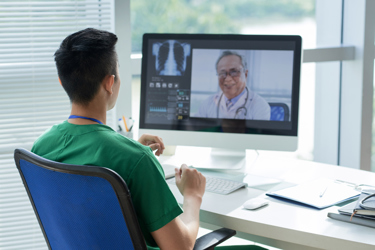Combating The Coronavirus With Telemedicine
By Samant Virk, MD, MediSprout

The new coronavirus (COVID-19), recently declared by the World Health Organization (WHO) an international public health emergency, is hitting closer to home. The virus has infected tens of thousands and continues to spread globally, prompting U.S. healthcare providers—many who are already stretched thin during the busy flu season—to question how they will accommodate a potential spike in visit volume while protecting their patients and themselves.
Telemedicine is proving to be an increasingly valuable tool in their medical arsenal, helping to reduce the spread of infection by providing first-line defense. Much like it has done for doctors assessing and treating patients for influenza—where its use has hit an all-time high—televisits can help doctors combat a coronavirus outbreak, even reaching patients in remote locations who have limited access to care. Here’s a closer look at how it promotes early detection, limits exposure, and helps providers treat more patients.
Understanding The Value Of Telehealth To Promote Early Diagnosis And Curb Potential Spread Of Coronavirus
Televisits, also known as remote healthcare visits, are teleconferences typically conducted via smartphones and personal computers. They provide a safe, efficient way for patients to connect with their own doctors from the comfort of their homes.
The remote visits are effective for many clinical needs, especially less complex visits that do not require in-office appointments. They are proving increasingly valuable for reducing the spread of infectious diseases, such as flu and coronavirus, because they enable early diagnosis and help to prevent exposure to the virus by keeping sick people away from others.
Patients, including those with limited access to care, are often more likely to seek care at the first signs of illness when care is convenient. Before the coronavirus outbreak, patients were often quick to brush off common symptoms, including cough, fever and body aches, as signs of a common cold. Because the new coronavirus shares many of the same symptoms as a cold and flu, the symptoms cause new concern. Meeting with their doctor for assurance via a video chat is quick and easy. It saves patients from taking time off from work or school, traveling to an office visit, or resorting to urgent care facilities and hospital emergency rooms, and also avoids the spread of disease from people who have minimal symptoms but can be infectious.
With remote visits, physicians connect with patients using screening questions, much like they would in an in-office setting, to gather history, assess symptoms, and check for signs of contagious illness. With telemedicine solutions such as V2MD, physicians can connect medical devices to the videoconference to collect vital information to lead to a quicker diagnosis.
Patients with more serious conditions can schedule an in-office follow-up visit or be referred to specialists. If coronavirus is suspected using CDC clinical guidelines and travel history, physicians can follow CDC instructions to direct patients for proper testing, quarantine those suspected of exposure, and notify local or state health departments, quickly and easily.
Limiting Coronavirus Exposure, Including To Those On The Front Lines
Since there is currently no vaccine for coronavirus, the CDC advises that the best way to prevent infection is to avoid exposure. Telemedicine reduces the spread of infection by keeping patients away from others. Sick people stay home rather than exposing others, including their doctors and anyone they encounter en route to a doctor’s appointment or in a healthcare facility.
While healthcare providers take precautions to minimize exposure in medical facilities, for instance using facemasks and other protective equipment, and following handwashing and hygiene recommendations, avoiding the transfer of germs entirely is unavoidable. Healthcare providers put themselves at risk of contracting viruses when they are in close contact with patients. Being able to connect and diagnose remotely helps to keep them free from germs, and ultimately able to help more patients.
Helping Providers Accommodate More Patients
A potential surge in patient demand, as would be seen in a widespread coronavirus outbreak, is a serious logistical concern for providers. They can’t turn their backs on patients who need care, especially during a crisis that demands immediate attention, yet they are limited by the number of patients visits they can accommodate in a day.
Televisits offer an efficient solution. By relying on televisits—which typically last about 10 minutes and can often be conducted before or after traditional office hours, as reimbursable visits—providers can better control their schedule and meet the needs of more patients. They can leverage remote visits to screen patients for illnesses that require additional attention (including coronavirus), refer serious cases for additional care, call in prescription medications, and provide follow-up for those already under their care. In-office visits can be reserved for patients with more complicated needs.
Telemedicine — Meeting Modern Demands
Like other professions, healthcare providers are forced to evolve to meet changing needs. They need new tools, like telehealth, to better protect, care for, and accommodate patients. The use of televisits will prove increasingly helpful in the fight against new, communicable diseases, including a widespread outbreak like coronavirus.
